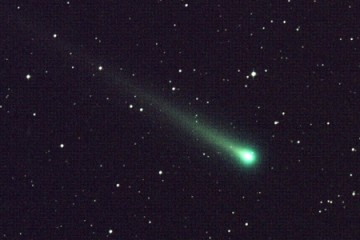Johns Hopkins University astrophysicist Stephan McCandliss and his team of graduate and undergraduate students had been working since spring to get a NASA-funded sounding rocket and the telescope it carries off the ground and into the sky. Its mission: to observe the far-ultraviolet emissions from Comet ISON, a ball of ice, dust, and gas currently traveling toward a close encounter with the sun.
After an initial launch attempt failed, the rocket—named FORTIS, short for Far-ultraviolet Off Rowland-circle Telescope for Imaging and Spectroscopy—finally took flight before dawn last week from a New Mexico desert.
"We're very happy," said McCandliss, who is also the principal investigator on the project. "The payload landed 15 minutes after launch. The team just got back from recovery and the experiment is in excellent shape."
ISON, which is expected to become unusually bright as it passes by Earth later this week, has generated considerable scientific interest, prompting ground- and space-based NASA observatories (and many other observatories around the world) to schedule observations as it plunges toward the sun. Another Johns Hopkins-managed mission, NASA's Messenger spacecraft, collected data last week as the comet passed near its position in orbit around Mercury.
FORTIS was launched from the White Sands Missile Range in New Mexico at around 6:40 a.m. EST on Nov. 20 and traveled 170 miles above the Earth's atmosphere. As the payload centered the comet in its field of view, a series of shutters snapped opened to gather information from the comet. The collection instrument, called a spectrograph, observed an area around the comet approximately 625,000 miles on a side.
Even before the reusable FORTIS was first launched and recovered in May 2013, McCandliss and his Johns Hopkins and Goddard Space Flight Center co-investigators had already proposed to NASA to launch it again to look for hydrogen, oxygen, and carbon monoxide emissions from ISON. The comet, named for a night-sky survey program at the International Scientific Optical Network, is expect to come as close as 1.2 million miles from the surface of the sun on Nov. 28. Whether ISON will survive its close encounter with the sun before it slingshots back into the outer solar system, likely never to return, is a question of great interest to the community of comet watchers.
McCandliss and his team sought funding from NASA to quickly launch FORTIS again since ISON came from the outer regions of the solar system, and thus and may have a composition similar to the cloud from which the sun and planets originally formed. FORTIS's spectrograph can help astronomers determine the comet's composition, McCandliss said, and NASA agreed this was an excellent opportunity and gave the team an accelerated go for launch.
The small window of opportunity from May to November put extra pressure on McCandliss and his team to get FORTIS back up into the sky. While the first FORTIS launch was a success, the rocket's re-entry and return to solid ground in May left it "pretty beat up," McCandliss said.
He and his team of graduate and undergraduate students worked closely with NASA's Sounding Rocket Operations Contractor to rebuild and ready the payload for a flight originally scheduled to launch before dawn on Tuesday last week. Those plans had to be scrubbed, however, due to a problem with a sticky vacuum isolation valve. The team worked through dawn to identify and fix problem, and the next morning, "the launch went off without a hitch," McCandliss said.
Sounding rockets fly on parabolic trajectories, typically carrying instruments that perform scientific experiments during flight. The rockets are used to carry instruments into space between 60 to 930 miles above the Earth's surface.
"Good data was collected and our analysis is ongoing," McCandliss said. "The experimenters are happy, but it's really important to acknowledge the sacrifices of their family members and colleagues who were patient and worked so diligently over the last five months to pull this mission together on such an abbreviated time scale. It was a great flight carried out under difficult circumstances and we would like to thank everybody who was involved."
Posted in Science+Technology









